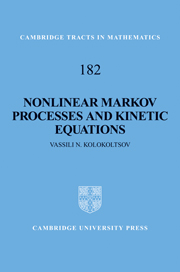Book contents
- Frontmatter
- Contents
- Preface
- Basic definitions, notation and abbreviations
- 1 Introduction
- Part I Tools from Markov process theory
- Part II Nonlinear Markov processes and semigroups
- Part III Applications to interacting particles
- 9 The dynamic law of large numbers
- 10 The dynamic central limit theorem
- 11 Developments and comments
- Appendices
9 - The dynamic law of large numbers
from Part III - Applications to interacting particles
Published online by Cambridge University Press: 05 July 2014
- Frontmatter
- Contents
- Preface
- Basic definitions, notation and abbreviations
- 1 Introduction
- Part I Tools from Markov process theory
- Part II Nonlinear Markov processes and semigroups
- Part III Applications to interacting particles
- 9 The dynamic law of large numbers
- 10 The dynamic central limit theorem
- 11 Developments and comments
- Appendices
Summary
In the introduction to this book general kinetic equations were obtained as the law of large numbers (LLN) limit of rather general Markov models of interacting particles. This deduction can be called informal, because the limit was performed (albeit quite rigorously) on the forms of the corresponding equations rather than on their solutions, and only the latter type of limit can make any practical sense. Thus it was noted that, in order to make the theory work properly, one has to complete two tasks: to obtain the well-posedness of the limiting kinetic equations (specifying nonlinear Markov processes) and to prove the convergence of the approximating processes to the solutions of these kinetic equations. The first task was settled in Part II. In this chapter we address the second task by proving the convergence of approximations and also supplying precise estimates for error terms.
We can proceed either analytically using semigroup methods or by working directly with the convergence of stochastic processes. Each method has its advantages, and we shall demonstrate both. To obtain the convergence of semigroups we need to estimate the difference between the approximating and limiting generators on a sufficiently rich class of functionals (forming a core for the limiting generator). In Section 9.1 we calculate this difference explicitly for functionals on measures having well-defined first- and second-order variational derivatives. Section 9.2 is devoted to the case of limiting generators of Lévy—Khintchine type with bounded coefficients.
- Type
- Chapter
- Information
- Nonlinear Markov Processes and Kinetic Equations , pp. 225 - 251Publisher: Cambridge University PressPrint publication year: 2010



